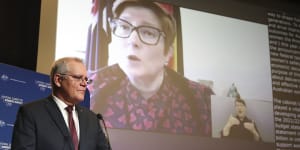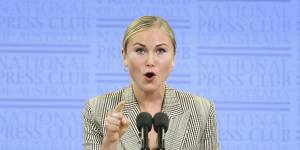It was “far from the only platform for change”,she tweeted. “Our hard-won advocacy pre-dates this event and will live on beyond it.”

Prime Minister Scott Morrison and Minister for Women Marise Payne on the screen during the National Summit on Women’s Safety.Alex Ellinghausen
The summit was always going to face a tough job living up to its hype,which took on heightened significance after a series of allegations of sexual assault and harassment in Parliament House led to street marches and protests.
Now the nation’s policymakers have to work out how to turn the demands it produced into a workable 12-year plan to end violence against women and children.
The need for greater action is urgent.
Almost a quarter of Australian women have experienced violence from an intimate partner. The proportion of women reporting their partners emotionally abused them has risen by almost a third. On average,one woman is killed each week by their partner.
“We need to get on with it,” says Jacqui Watt,head of No To Violence.
The stakes were pushed higher in April when Prime Minister Scott Morrison announced the summit’s timing,linking it with remarks about the response to the Respect@Work report on workplace sexual harassment.
That long-awaited response,,had become emblematic of the poor treatment of women. Full implementation of Respect@Work’s 55 recommendations was among the demands of the tens of thousands of women attending the,inspired by Brittany Higgins’ allegations of being raped in that same building.
Although the perception was the summit was part of dealing with the government’s “women problem”,its genesis was last December,when a women’s safety taskforce was formed with the ministers from every state,territory and the Commonwealth. Part of its remit was organising a summit to inform development of the next national plan to reduce violence against women and children.
Similar events had been held in 2016 and 2018. The first was essentially a COAG meeting,with the associated public posturing by leaders. The 2018 summit in Adelaide was enthusiastic but low-key;Morrison spent those two days in Perth.
Watt,who was involved in the previous two summits,says this year’s national conversation about the treatment of women meant there was a much bigger group of people who wanted to engage. There are also now a core group of outspoken victim-survivors – like Higgins and Tame,the Australian of the Year – drawing attention to the issues.

Anti-child abuse campaigner Grace Tame will push for nationally consistent definitions of consent and sexual abuse.Alex Ellinghausen
This wider interest and the COVID-induced lockdowns that sent the summit online led to disappointment from some about a lack of inclusiveness. Higgins said she only became a delegate after a last-minute invitation from the ACT. Tame was on a panel,but tweeted that she’d had to remind the government it had invited her.
Domestic Violence NSW chief executive Delia Donovan agrees summit discussions weren’t as robust or interactive as at an in-person event,although “it’s no one’s fault,it was COVID”. But she believes the sector did the necessary heavy lifting of consultation in the lead-up.
This included two days of roundtable discussions held last week,closed to the public,that allowed deeper examination of issues.
Despite the trials of a virtual summit,Hayley Foster,the head of counselling and advocacy organisation Rape and Domestic Violence Services Australia,is hopeful.
She was encouraged by the sentiments from ministers at the summit’s end. She also has hope after described the $1.1 billion in the last federal budget as a “down payment”.
“We’re all holding our breath,” Foster says. “There are words and sentiment,and then there are actions. There’s been a fair amount of inaction over the last 11 to 12 years.”
The first national plan ran from 2010 to 2022,with the overarching goals delivered through a series of three-year action plans.
The – based on 2016 data – shows progress was made on three of its four headline measures. But on the fourth,reduced prevalence of domestic violence and sexual assault,things got worse.
Advocates say on actual reduction of violence,although they agree the first plan has led to important infrastructure being put in place.
A draft version of the next 12-year plan should be ready before the end of the year. It will formally start in July 2022.
But advocates want action before then.
Dr Michael Salter,an expert on gendered violence with the University of NSW,says the looming federal election could pose challenges to policymaking,but there must be change as soon as possible.
“We cannot wait according to the whims of the electoral cycle before we see implementation because women are dying now. They’re dying every single week,” he said. “The public is really sick of talk. The public wants to see real action and real results.”
Victoria’s Minister for Women Gabrielle Williams used her closing remarks to the summit to take aim at what she saw as sluggishness from the Commonwealth. This prompted to maintain the nonpartisan,collaborative approach.
Later,Williams said her government would work collaboratively but pointed out the evidence was there for the Commonwealth to act on a range of areas including housing affordability and boosting funding for legal services.
“We’re almost a year away from when this[new plan] would come into effect and that’s too long to wait when we know there are areas in need of urgent attention now,” she said.
Federal Women’s Safety Minister Anne Ruston acknowledges the urgency.
“We cannot look back and say the summit was just a talkfest and the next national plan cannot be a document that just sits on a shelf,” she said. “It must translate into real and practical outcomes and actions because we have to change the dial and we have to make a difference – lives depend on it.”
One suggestion repeatedly raised for governments to act on immediately is legislating nationally consistent definitions of terms such as consent and.
There isn’t even a consistent definition of domestic violence,a decade after concerted action began to tackle it.
Tame announced during the summit she was to get the nation’s attorneys-general to fix this.
“We have nine jurisdictions with nine very different definitions of consent. We have nine definitions of grooming and in some jurisdictions grooming isn’t even defined at all... Nine different definitions of the age of consent to sex and nine different definitions of sexual intercourse itself,” she said.
“We wonder why we don’t have a consistent understanding of each of these concepts.”
The lack of consistency also translates to difficulty in assessing whether programs are working.
“How do you make sense of the data or join up the data when you don’t even have consistent definitions? Because you’re not collecting the same things,” says Padma Raman,head of Australia’s National Research Organisation for Women’s Safety.
“It does feel like there are pockets of activity over the place,and it’s just not coordinated.”
Donovan said the sector was “constantly talking about transparency,accountability,and good governance” for both governments and services,and that should be embedded in the new plan.
“Until we’ve got a national definition,and national minimum standards,we really can’t measure ourselves very well,” she said.
Another frequent theme is the need for different services to suit different communities. The “one size fits all” approach set programs up to fail,Queensland Indigenous Family Violence Legal Service principal solicitor Thelma Schwartz said.
Watt points out using a tailored approach comes back to consistent data and evaluation to make sure governments properly understand what is happening on the ground.
“If we need more police,we need more police. But if we need more social workers[that needs to be known],” she says.
“By the time police get[involved],it’s probably happened five or six times before. It would be better if you could get there before the police get called.”
The call for tailored approaches came loudly from Indigenous leaders,who said when they suggested solutions. The delegates’ statement asked for a specific action plan for Aboriginal and Torres Strait Islander women and children,to sit under the national plan.
Ruston said she had heard this message “loud and clear”.
“It makes absolute sense to establish a standalone action plan,” she said. “It’s not good enough for Indigenous women to feel like they have just been tagged on or added on as an afterthought.”
Then there’s the question of money to back up the intentions of the plan.
Services are,with most on short-term funding arrangements that make it difficult to plan.
“Year after year we are begging for money,begging for funding to support over 60 Aboriginal and Torres Strait Islander communities,” Schwartz said. “How is that acceptable ...[to] go cap in hand begging to provide essential services?”
Donovan says funding for frontline services should at least double,while Foster says there needs to be a billion dollars a year – compared with the $1.1 billion over four years in the federal budget.
Yet Payne said at the end of the two days that if anyone walked away thinking the only answer was more funding,“they would have taken the wrong outcome from this summit”.
Melbourne University law professor Heather Douglas was shocked when she heard that.
“We do know about a lot of programs that are working well. But unfortunately,a lot of them get stuck in this sort of pilot project status,” she said. “It’s not long term. It’s not sustained … and that’s really problematic.”
Foster says this permanent short-term funding is incredibly wasteful,means people started from scratch when they could be setting up a program that was already working,and often leaves services with little time or resources to do the primary prevention work governments agreed was so vital.
“They’ve still got families in crisis coming to them,and they drop everything and do the crisis work,” she said.
“They’re never going to be able to get that early intervention and prevention work done at the local level unless[governments] make that brave expenditure.”
Salter said there was no doubt calls for more money were always challenging to governments,especially for long-term investments.
“But I don’t think there’s any two ways about it. If we want to reduce violence against women and children,then we are going to have to see significant financial commitments from the public purse.”
Ruston said the way the current plan was carved up into the three-year action plans “created a stop-start approach to funding”. That created uncertainty for the sector as well as not allowing enough time for delivery and evaluation.
“This has created duplication as well as gaps which is why the next national plan must set out clearly the responsibilities of each level of government as well as the business sector and community more broadly,so we can ensure there is accountability,” she said.
Ultimately,women dealing with domestic violence or sexual assault don’t care who the money comes from,Watt says. They just want the services to be similar and accessible no matter where they are.
“Unless we drop the politics and get really ambitious,we’re not going to get there.”
Support is available from the at 1800RESPECT (1800 737 732).
The Morning Edition newsletter is our guide to the day’s most important and interesting stories,analysis and insights..